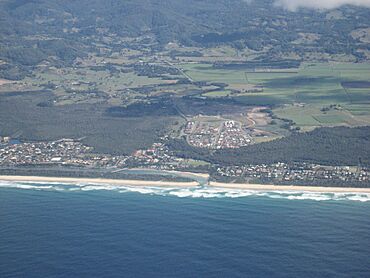Pottsville, New South Wales facts for kids
Quick facts for kids PottsvilleNew South Wales |
|
|---|---|

Aerial photograph of Pottsville in 2007
|
|
| Population | 7,209 (2021 census) |
| Postcode(s) | 2489 |
| LGA(s) | Tweed Shire |
| Region | Northern Rivers |
Pottsville is a lovely coastal town located in the beautiful Northern Rivers area of New South Wales, Australia. It's part of the Tweed Shire region. In 2021, about 7,209 people called Pottsville home. This town got its start thanks to a man named Bill Potts, who built the very first house here around 1930. Because of him, the area was first called Potts Point. However, to avoid confusion with another place called Potts Point in Sydney, the town was soon renamed Pottsville.
Pottsville is home to several different neighborhoods, like Pottsville Waters, Koala Beach, Seabreeze, and Black Rocks Estate. It also has two schools for young learners: Pottsville Beach Public School and St Ambrose Primary School.
Pottsville's Story
Pottsville has an interesting past. It began as a quiet, natural area, with some parts even being tea tree swamps. The town's modern history really started in 1930 when Bill Potts built the first home. This led to the area being known as Potts Point. But, as mentioned, the name was changed to Pottsville to make sure people didn't mix it up with the Potts Point suburb in Sydney.
Over the years, Pottsville has grown quite a bit. The number of people living here has steadily increased. For example, in the 2021 census, the population was 7,209. You can see how the population has changed over time in the table below.
Today, Pottsville is known as a peaceful coastal town. It's a popular spot for people who love the beach and for families looking for a nice place to stay during holidays. Its beautiful beaches and calm atmosphere make it a great place to visit or live.
| Historical population | ||
|---|---|---|
| Year | Pop. | ±% |
| 1971 | 245 | — |
| 1976 | 332 | +35.5% |
| 1981 | 673 | +102.7% |
| 1986 | 621 | −7.7% |
| 1991 | 1,293 | +108.2% |
| 1996 | 1,987 | +53.7% |
| 2001 | 2,576 | +29.6% |
| 2006 | 3,298 | +28.0% |
| 2011 | 5,735 | +73.9% |
| 2016 | 6,550 | +14.2% |
| 2021 | 7,209 | +10.1% |
| Source: Australian Bureau of Statistics data. | ||


